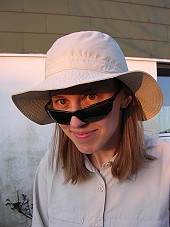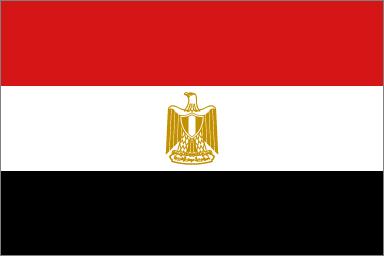
MARTINA'S WORLD TRIP
EGYPT: April 25 - May 18, 2004


(Übersetzungshilfe)
 |
MARTINA'S WORLD TRIP EGYPT: April 25 - May 18, 2004 |
|||||||
 |
||||||||
 |
Your Dictionary
(Übersetzungshilfe) |
|||||||
| Friday, May 14th, 2004 - Alexandria II | ||||||
| Friday, May 14th, 2004 - Alexandria II Today we were joined by a local guide. It was a young woman called Soha. First, we visited the Graeco-Roman Museum of Alexandria. It contains about 40.000 relics dating from as early as the 3rd century BC. The museum is very well done and Soha did a great tour. Lots of bits and pieces we had heard about Egyptian history earlier on our tour suddenly fell in place and it was as if finally all puzzle pieces turned into a complete picture. Here are several things I learned during the visit and which I’d like to remember: - Ptolemy X, who was one of the Macedonian Greek pharaohs following Alexander the Great on the throne of Egypt, was obviously fond of the old Egyptian culture and tried to copy their ancient style when he had a statue designed showing him in the pharaonic outfit and a typical pose of Ramses II. The result was a 2-meter high statue of an Egyptian pharaoh with a face like Günther Pfitzmann!! - During Graeco-Roman times people in Egypt spoke a lot of different languages: Greek, Latin, Arabic, etc. In addition, most people couldn’t read or write. Still, people wanted to have something ‘written’ on their gravestones so everybody could see and understand who they were in their lifetime. Therefore, they simply engraved pictures on the stones, some of them on display at the museum. They sometimes showed the profession of the dead person (e.g. farmer or merchant), sometimes a couple or parents with their beloved child. Soha’s favourite gravestone showed a big lady holding a mirror in her hand, being fanned by a small servant. It was obvious she would be remembered for her beauty… or vanity! - Some people couldn’t afford a coffin - so they were buried in their bathtub used as sarcophagus! - When Graeco-Roman merchants or soldiers travelled, they sometimes were gone for a very long time. Obviously, photography didn’t exist yet, so the only way to take a memory of their families “with them” was by small wooden or ceramic statues showing the bust of their wives or a replica of their children. Lots of them could be seen at the museum, given an interesting insight in the variety of robes and hairstyles fashionable at the time. Amazingly enough, the women’s robes were very colourful and not all creme white like usually portrayed in movies about ancient Rome! - The oldest coins ever found dated back to the 7th century BC; they were actually discovered in Turkey. Soon copied by the Romans, the museum had plenty of coins on exhibition. The oldest here were coins bearing a portrait of Alexander the Great around 300 BC. Some others showed the famous lighthouse of Alexandria, known as one of the ancient Seven Wonders of the World. As there are hardly any images existing of the old ‘Pharos’, these coins are extremely important for today’s research about the massive tower that took 12 years to be built. It was finally completed in 283 BC and withstood winds and floods for a total of 17 centuries before it was destroyed by a violent earthquake in 1303. Most interestingly, we could see genuine coins and their forged copies, so money forgery isn’t a disease of capitalism! - Last but not least, my biggest disappointment: Cleopatra was NOT beautiful at all but looked like Virginia Woolf!!! After the museum we went to see the Catacombs of Kom Ash-Shuqqafa. These catacombs, the largest known Roman burial site in Egypt, were discovered accidentally in 1900 when a donkey fell in the shaft of a well and disappeared through the ground. Unfortunately, he didn’t survive the discovery. The catacombs consist of three levels of tombs and chambers cut out of the rock to a depth of about 35 meters. The bottom level is flooded and inaccessible but the other areas can be visited. It is a very impressive site, constructed in the 2nd century AD probably as a family crypt, but over time, more chambers were hacked out until the complex had expanded to accommodate more than 300 corpses. The bodies of the dead were lowered on ropes down the centre of a shaft where a little flooded canal led them further down towards the graves. The principal tomb is a miniature funerary temple, decorated with a weird synthesis of ancient Egyptian, Greek and Roman death icons. For instance, as you enter the inner chamber, on either side of the doorway are carved figures representing Anubis, the Egyptian god of the dead, but dressed as a Roman legionary and with a serpent’s tail representative of a Greek divinity. Also, the artist who had made the statues of a man and woman standing in the niches left and right of the antechamber made a huge mistake that we - well trained after 3 weeks of Egyptian sight seeing - discovered even before Soha pointed it out to us: Trying to achieve perfect symmetry on both sides of the doorway, he had designed one of the statues putting the left foot forward and the other one the right. Major mistake!! Only the left leg should be stretched out because this is the pharaonic position demonstrating their ruling power!
Our third and last stop was at the remains of a Roman acropolis known as the Serapeum (see pictures). Here stands Pompey’s Pillar, a 30-meter high granite column with a circumference of 9 meters. It was erected in AD 293 but during the final assault on the pagan intellectuals of Alexandria, the Christians destroyed the Serapeum and its library around AD 391.Only the pillar remained. It is, in fact, the only ancient monument remaining whole and standing in Alexandria. After we had ended our guided tour, we had lunch at the waterfront. Vincent and Neal had sponsored bread, cheese, mixed pickles and Falaffel, which we enjoyed in the sun. The afternoon was free and I spent 5 hours at the internet café again. For dinner we went to a local restaurant in the city centre and I did the first real nutrition mistake since I’ve been travelling: I ordered tomato soup and strawberry juice for dinner. This night, I still enjoyed it - wait until you read about tomorrow! Following dinner, we decided to go out for a drink and went to the “Spitfire Bar”. This bar is a great place: although full of smoke and beer smell, it is very cosy and full of memories. There are stickers, signboards, company nameplates and photos all over the place, a living proof of 40 years serving their clients from all over the world. There was even a sign with a shipment company’s name from Cuxhaven! (= the place from where ships leave to Helgoland) I really wished I had a Helgoland sticker with me... The day ended with a special encounter. Sarah, Andrea and I didn’t want to stay as late as the guys, so we started walking back to the hotel at some point. We had to take the tram again but the women’s compartment was so crowded that we went into the regular one. The waggon had two floors and when we came upstairs I was aiming at the next free seat. Suddenly, I heard a male voice: ”hello”, I didn’t react. He continued “hello, hello” and already got on my nerves. I didn’t even look up because I didn’t want to encourage him and just waited for Sarah and Andrea to sit down with me. Then I saw this hand reaching over to my bench, still trying to catch my attention. I was on the verge of shouting at the guy when I heard Sarah replying “hello!” to the supposed stranger. I couldn’t believe she actually reacted to the guy and finally looked up: the people she greeted so happily were Ahmed and Atif, our guide and driver! I felt so embarrassed and was ashamed of myself for having ignored them so stubbornly. Anyway, in the end we went home together which was nice because we felt kind of protected in their company. Indeed, Atif went back to talk to an Egyptian guy in the street who had hissed at us and said something harassing in Arabic. It felt great to be escorted! Shortly before we arrived at the hotel, we witnessed two interesting scenes: the first was a child’s birthday party at some sort of an ice café. To me it seemed that the party was more for the adults than for the child who was a little boy just turning one year old. Apart from an even younger baby, no other children were around and he didn’t seem to understand at all what was going on. At least, the rest of the family seemed to have fun, singing children songs and making themselves ridiculous in front of the confused boy… Well, other countries other customs - I couldn’t imagine a celebration like this at 11 pm in Germany! The second party we passed by was an Arabic wedding in one of the hotels next to ours. The guests were dancing to local music and the place was crowded with people. Thanks to Atif, we were even invited to go inside. Sarah and Andrea followed the invitation and told me afterwards how embarrassed they were being introduced to the beautiful bride in their 3-weeks adventure vacation outfit! I somehow thought that I wouldn’t want tourists at my wedding, so I did not join, although Atif tried to assure me that EVERYBODY was welcome… |
||||||